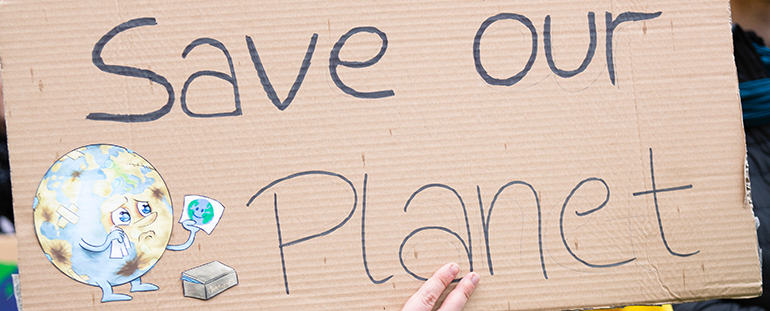
By Avneet Sidhu
The coronavirus (COVID-19) pandemic has caused numerous negative impacts on daily life, public health, and the economy. The impacts on the environment include suddenly clear skies over some of the most air-polluted cities and regions. Environmental lawyers and professionals recognize the parallels between the impacts of the public health crisis and climate change, and the land use planning, infrastructure, and systems required to effectively respond to both. On a practical level, the lockdown in response to the pandemic provides a case study in support of existing policies directed at a reduction in transportation impacts. On a policy level, the disproportionate impact of the pandemic (both the virus and the lockdown) on low-income communities, minorities, women, the elderly, and those with preexisting health conditions, underscores the importance of balancing policies focused on climate change with environmental justice.
The abrupt reduction in daily driving, flying, and industrial output in response to the pandemic resulted in a number of short-term physical impacts on the environment, including a rapid, dramatic drop in greenhouse gas (GHG) emissions worldwide. The positive impacts were short-lived, however, and the sharp decline in daily emissions has already begun to shrink as many nations open up in an effort to get their economies back to pre-pandemic levels.
Although the impacts of COVID-19 on air quality were temporary and not enough to keep global warming in line with the requirements outlined in the Paris Climate Agreement,1 even the temporary respite from business-as-usual provides an opportunity to evaluate what worked and if those changes can be, or should be, sustained. Since 2006, state law has increasingly incentivized new projects and policies that include denser infill development; reductions in individual vehicle use; and/or increased or improved public transportation.2 Many of the changes made during the COVID-19 pandemic that contributed to the reduction in emissions were by existing businesses, such as increasing remote working and decreasing in-person meetings and business travel, which may encourage individuals to make future operational changes to reduce emissions from existing businesses, buildings, and uses.
On the planning and policy level, one lesson learned from the pandemic is that efforts to increase public health issues and to reduce GHG emissions have to be balanced with factors like age, existing health conditions, income inequities, inadequate housing, employment opportunities and availability, and racism, to ensure the policy does not marginalize vulnerable communities. For example, while technology has already improved during the pandemic (therefore allowing for remote working and less travel), equitable access to technology remains an issue in many lower-income communities and households.
So, while dense, infill development is being touted as a victory for climate change, consideration should be given for impacts to public health associated with closer quarters and less outdoor space. Since 2016, state law has required cities and counties with “disadvantaged communities”3 to incorporate environmental justice (EJ) policies into their general plans, as local government’s long-term blueprint for the community’s vision of future growth.4 “Environmental justice” is defined as “the fair treatment and meaningful involvement of people of all races, cultures, incomes, and national origins, with respect to the development, adoption, implementation, and enforcement of environmental laws, regulations, and policies.”5 Examples of what cities and counties should consider include: the equitable distribution of new public facilities and services; siting of polluting facilities to minimize overconcentration in any one area of health and safety hazards; siting new schools and residential dwellings to avoid proximity to industrial areas; and promoting livable communities to maximize transit-oriented development so residents minimize traffic and air pollution impacts.6
Cities and counties that do not have “disadvantaged communities” are not required to consider EJ policies in their general plans. Recent experience with COVID-19 impacts is perhaps the additional incentive we need to encourage voluntary consideration of EJ policies as general plans are updated and individual development projects are reviewed, as we strive to meet the state’s ambitious timeline for climate change and to protect against the impacts of the current, and future, health and financial crisis.
- “Cut Global Emissions by 7.6 Percent Every Year for Next Decade to
Meet 1.5°C Paris Target-UN Report,” United Nations Climate Change, November 26, 2019, https://unfccc.int/news/cut-global-emissions-by-76-percent-every-year-for-nextdecade-to-meet-15degc-paristarget-un-report. - One of the primary tools for analyzing environmental impacts is the California Environmental Quality Act (CEQA) (Public Resources Code §21000 et seq.) and the CEQA Guidelines (California Code of Regulations, Title 14 § 15000 et seq.).
- “Disadvantaged communities” is defined in Government Code §
65302(h)(4)(A) as “an area identified by the California Environmental Protection Agency pursuant to Section 39711 of the Health and Safety Code or an area that is a low-income area that is disproportionately affected by environmental pollution and other hazards that can lead to negative health effects, exposure, or environmental degradation.”
The statute further defines “low income area” to mean “an area with household incomes at or below 80 percent of the statewide median
income or with household incomes at or below the threshold designated as low income by the Department of Housing and Community Developments list of state income limits adopted pursuant to Section 50093” (Gov. Code § 65302(h)(4)(C)). - Government Code § 65302(h).
- Government Code § 65040.12(e).
- “The State of California General PlanGuidelines (2017),” Governor’s Office of Planning and Research, July 31, 2017, http://www.opr.ca.gov/docs/OPR_COMPLETE_7.31.17.pdf. As of writing, OPR has not released the anticipated new Environmental Justice Guidance for General Plans.
Avneet Sidhu is a Partner at Grid Legal, LLP, specializing in real property transactions, land use and development projects, and environmental review under the California Environmental Quality Act (CEQA). Avneet is the Chair of the Environmental/Land Use Law Section of the San Diego County Bar Association and a lecturer in business law at San Diego State University.